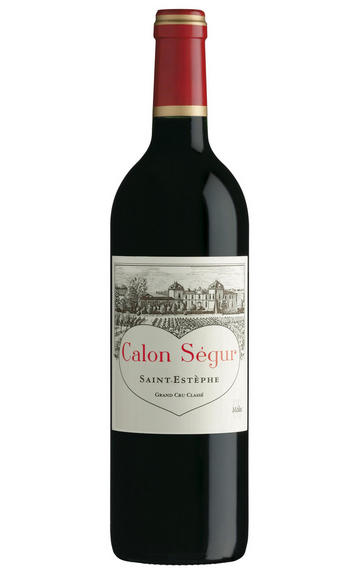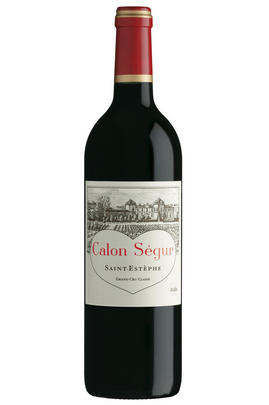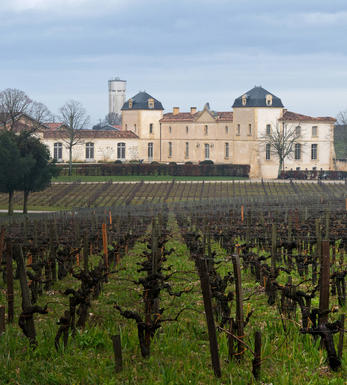
2015 Château Calon Ségur, St Estèphe, Bordeaux

Critics reviews
Tasted blind at the Southwold 2015 Bordeaux tasting.
The 2015 Calon-Ségur has a fresh and very well-defined bouquet of raspberry, wild strawberry and crushed stone aromas, very focused and beautifully integrated new oak. The palate is medium-bodied with fine grain tannin, well-judged acidity, lightly spiced and quite saline toward the marine-tinged finish that fans out beautifully. There is classiness in this Saint-Estèphe and it should age with grace.
Neal Martin, Vinous.com (July 2019)
The blend is 82% Cabernet Sauvignon, 16% Merlot and 2% Petit Verdot.
The 2015 Calon Ségur is a very pretty, if somewhat one-dimensional wine with good brightness in its floral-infused red berry fruit. The purity of aromas and flavours is striking, but the texture, dimension and complexity of the very best years are elusive. The 2015 is an attractive, mid-weight Calon Ségur to drink while some of the more recent vintages, especially the 2014 and 2016, are left to age in the cellar.
Drink 2023 - 2040
Antonio Galloni, Vinous.com (February 2018)
Composed of 82% Cabernet Sauvignon, 16% Merlot and 2% Petit Verdot, the 2015 Calon-Segur was aged in 100% new French oak barrels for 20 months. It has a deep garnet-purple colour and a nose of warm blackberries, cassis, black cherries and licorice with touches of roses and dark chocolate. The medium-bodied palate is firm and chewy with good concentration and a spicy finish.
Drink 2020 - 2042
Lisa Perrotti-Brown MW, Wine Advocate (February 2018)
82% Cabernet Sauvignon, 16% Merlot, 2% Petit Verdot. 47 hl/ha. 20 months in 100% new oak.
Dark crimson. Pure and aromatic. Pretty dense and dry with a hint of sweet oak. Solid and concentrated. All set for the long term. Pretty introvert. Edgy finish but more sweetness than there used to be. Intense – more intense than usual for this property. A little attenuated on the end. Very solid indeed!
Drink 2024 - 2036
Jancis Robinson MW, JancisRobinson.com (April 2016)
Aromas of blackberries, currants, cedar and tobacco. Full-bodied, layered and dense. Great fruit yet tight and structured. A classically proportioned red with so much intensity. A wine for the future.
Try it in 2022
James Suckling, JamesSuckling.com (February 2018)
As Vincent Millet points out, in the context of St-Estèphe, '2015 is the opposite of 2014, marked by a very wet growing season' that included 180mm of rain from August to September. Although the first nose expresses caramel, spice and slightly woody notes, a quick airing of the wine reveals its elements of black fruit, liquorice, and graphite. More expressive is the lovely satin-like mouthfeel possessing real power, shaped by finely etched tannins and harmonious yet energetic acidity. Without a doubt, this is a superb wine that will require cellaring before unfurling all it has to offer in the coming years.
Drink 2022 - 2035
Yohan Castaing, Decanter.com (November 2021)
The 2015 Calon Ségur checks in slightly behind the 2014 and is a more sexy, rounded, forward effort that displays fabulous sweetness in its cassis and black currant fruits, spice, graphite, and floral aromas and flavors. With soft tannins, a lovely, elegant texture, and medium to full body, drink it any time over the coming 2+ decades.
Drink 2018 - 2038
Jeb Dunnuck, JebDunnuck.com (October 2018)
About this WINE

Chateau Calon Segur
Château Calon-Ségur, the most northerly of all the Médoc Grand-Crus Classés, is the château with a heart on its label. That is because the former owner, Marquis de Ségur, though he owned such Estates as Lafite and Latour, he declared "My heart belongs to Calon". For the last century it has been owned by the Gasqueton family.
Calon-Ségur's 74-hectare vineyard, which is partly enclosed by a wall, is located just to the north of the village of St-Estèphe. The vineyards (Cabernet Sauvignon 65%, Merlot 20%, Cabernet Franc 15%) lie on up to 5 metre deep gravel beds mixed with sand and, in parts, limestone and clay.
The wines are fermented for 3 weeks in enamel-lined steel vats and are then matured in oak barriques (40% new) for 18 months. Recently, Calon-Ségur has hit form with notable successes in 1995 and 1996 and 2000. At its best, Calon-Ségur produces meaty and concentrated wines displaying excellent depth of fruit and superb length. It is classified as a 3ème Cru Classé.

Saint-Estèphe
Saint-Estèphe is the northernmost of the most important communes of the Médoc and borders Pauillac on its southernmost border, with only a gully and stream separates it from Ch. Lafite. To the north lies the Bas-Médoc.
Saint-Estèphe is defined by the depth of its gravel, which is ubiquitous but of varying depths and occasionally very shallow, when clay predominates. This keeps the soil cooler and wetter than its counterparts so that the wines can appear fresh in lighter vintages, but superbly successful in hot, dry years.
The best châteaux in the south of the commune have the deepest soil and the thickest gravel. Cos d'Estournel has an exceptional terroir with its vineyards being located on a south-facing ridge of gravel with excellent drainage.
Saint-Estèphe is the least gravelly of main Médoc communes and in the north of the commune the vineyards are heavier and more clay-based leading to a rustic style of wine being produced.
The wines can appear austere in youth with a discernable ferric note at some châteaux, but the best typically display good depth of colour, pronounced acidity an tannins in youth and are exceptionally long-lived. At their best, they are the equal of almost any Bordeaux. The well-regarded St Estèphe co-operative controls the production of about half the appellation.
Recommended Châteaux
Cos (Ch. Cos d'Estournel), Ch. Montrose, Ch. Calon-Ségur, Ch. Lafon-Rochet, Ch. Les Ormes de Pez, Ch. Beau-Site, Ch. Cos Labory, Ch. Phélan-Ségur

Cabernet Sauvignon Blend
Cabernet Sauvignon lends itself particularly well in blends with Merlot. This is actually the archetypal Bordeaux blend, though in different proportions in the sub-regions and sometimes topped up with Cabernet Franc, Malbec, and Petit Verdot.
In the Médoc and Graves the percentage of Cabernet Sauvignon in the blend can range from 95% (Mouton-Rothschild) to as low as 40%. It is particularly suited to the dry, warm, free- draining, gravel-rich soils and is responsible for the redolent cassis characteristics as well as the depth of colour, tannic structure and pronounced acidity of Médoc wines. However 100% Cabernet Sauvignon wines can be slightly hollow-tasting in the middle palate and Merlot with its generous, fleshy fruit flavours acts as a perfect foil by filling in this cavity.
In St-Emilion and Pomerol, the blends are Merlot dominated as Cabernet Sauvignon can struggle to ripen there - when it is included, it adds structure and body to the wine. Sassicaia is the most famous Bordeaux blend in Italy and has spawned many imitations, whereby the blend is now firmly established in the New World and particularly in California and Australia.


Buying options
Add to wishlist
Description
Blend: 82% Cabernet Sauvignon, 16% Merlot, 2% Petit Verdot.
What a fabulous nose of warm, exotic herbs and spices... The palate has good concentration of mineral fruit, ripe tannins, tobacco and chocolate notes. There is concentration here and a thoroughly exciting and rewarding freshness. The coolness is really delicious. Full-bodied, robust and with masses of sweet fruit, it is a really great effort in 2015. A really excellent Calon Ségur, it is one of the most complete wines we have tasted for this vintage.
Berry Bros. & Rudd
wine at a glance
Delivery and quality guarantee